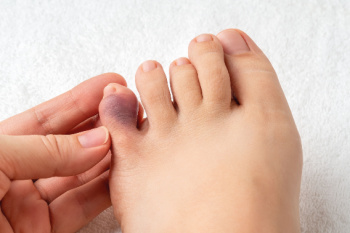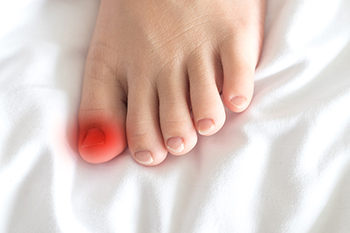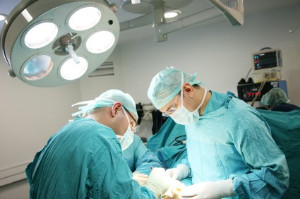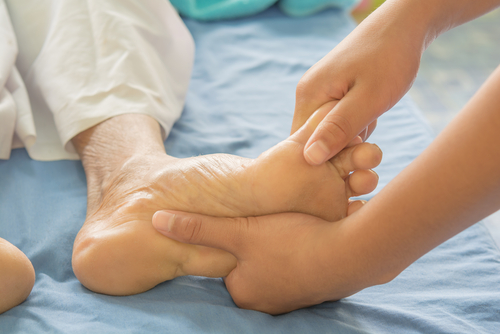Items filtered by date: September 2025
Extra Care Is the Ticket for Aging Feet
Feet naturally flatten out and widen with age, and fat pads, which had previously cushioned bones and joints, become worn down. This can cause foot pain, discomfort, and impaired mobility. Simple daily foot care can help older adults maintain foot and ankle health and prevent smaller issues from becoming serious ones. Shoes should be properly sized and offer arch and heel support. Feet should be kept clean to avoid infections and moisturized to avoid sores and cracked heels. Toenails should be trimmed straight across at the proper length to prevent ingrown toenails. Ankles should be elevated regularly to give heels a break from touching the floor or bed, which can lead to sores. If any type of foot sore develops, especially a diabetic ulcer, or there is any kind of foot or ankle pain, it is suggested that you seek the care of a podiatrist.
If you need your feet checked, contact Brandon M. Zuklie, DPM of New Jersey. Our doctor will attend to all of your foot and ankle needs and provide you with quality treatment.
Geriatrics and Podiatry
When people age, some common issues that may occur are bone density loss, dry skin, poor circulation, and rough brittle nails. These issues may also affect your foot health if the necessary steps are not taken to alleviate the problems.
It is important to take care of your feet because feet that are injured or diseased can affect your overall health. Having painful feet hinders your ability to do daily activities or may decrease your willingness to do the things that you need to do.
Visiting Your Geriatrician
As we age, health problems become more likely, so it is essential to visit your doctor for check-ups to ensure that you are doing the best you can to take care of your health. It is recommended to check your feet frequently for any possible cuts, bruises, swelling, corns or any other irregularities.
Taking Care of Elderly Feet
Cracked or dry feet can be treated by applying moisturizer often. It is also important not to wear old socks because the older the sock is, the higher the possibility there will be that there is bacteria there. Wear fresh socks and make sure they fit properly.
Proper foot health means that you can have a more active lifestyle and you will not be bogged down by pain. Foot health also leads to good circulation, which is paramount for overall health.
If you have any questions, please feel free to contact our offices located in Piscataway, Jamesburg, and Branchburg, NJ . We offer the newest diagnostic and treatment technologies for all your foot care needs.
See Your Foot Specialist Regularly If You Work On Your Feet
How to Tell if a Toe Is Broken

A broken toe can happen from something as simple as stubbing it on furniture or dropping a heavy object on the foot. Symptoms often include sharp pain, swelling, bruising, and difficulty walking. The toe may appear crooked or out of alignment, and it may feel tender or numb. In some cases, there may be a popping sound at the time of injury. While some fractures are obvious, others can be mistaken for a sprain. A podiatrist can provide an accurate diagnosis through a physical examination and imaging, such as an X-ray. Treatments vary depending on the severity of the break and may include splinting, buddy taping, protective footwear, or in some cases, surgery. Prompt care can help prevent complications, such as improper healing or long-term pain. It is suggested that you make an appointment with a podiatrist if you suspect a toe may be broken to ensure proper treatment and recovery.
A broken toe can be very painful and lead to complications if not properly fixed. If you have any concerns about your feet, contact Brandon M. Zuklie, DPM from New Jersey. Our doctor will treat your foot and ankle needs.
What to Know About a Broken Toe
Although most people try to avoid foot trauma such as banging, stubbing, or dropping heavy objects on their feet, the unfortunate fact is that it is a common occurrence. Given the fact that toes are positioned in front of the feet, they typically sustain the brunt of such trauma. When trauma occurs to a toe, the result can be a painful break (fracture).
Symptoms of a Broken Toe
- Throbbing pain
- Swelling
- Bruising on the skin and toenail
- The inability to move the toe
- Toe appears crooked or disfigured
- Tingling or numbness in the toe
Generally, it is best to stay off of the injured toe with the affected foot elevated.
Severe toe fractures may be treated with a splint, cast, and in some cases, minor surgery. Due to its position and the pressure it endures with daily activity, future complications can occur if the big toe is not properly treated.
If you have any questions, please feel free to contact our offices located in Piscataway, Jamesburg, and Branchburg, NJ . We offer the newest diagnostic and treatment technologies for all your foot care needs.
A Trusted Surgical Option for Ingrown Toenails

Ingrown toenails can cause persistent pain, swelling, and infection when the edge of the nail grows into the surrounding skin. While conservative care such as soaking, trimming, or antibiotics may provide temporary relief, some cases require a more lasting solution. One well-established approach is a minor surgical procedure that carefully removes the problem portion of the nail and reshapes the nail bed to prevent it from growing back incorrectly. This method, based on the Winograd technique, has been used for decades and continues to be a reliable option for patients struggling with recurring ingrown toenails. The procedure is performed under local anesthesia in a podiatrist’s office, with patients typically walking out the same day. Recovery is usually quick, and many find lasting comfort after years of discomfort. If ingrown toenails are interfering with daily life, it is suggested that you see a podiatrist for an evaluation and appropriate treatment.
Ingrown toenails can become painful if they are not treated properly. For more information about ingrown toenails, contact Brandon M. Zuklie, DPM of New Jersey. Our doctor can provide the care you need to keep you pain-free and on your feet.
Ingrown Toenails
Ingrown toenails occur when a toenail grows sideways into the bed of the nail, causing pain, swelling, and possibly infection.
Causes
- Bacterial infections
- Improper nail cutting such as cutting it too short or not straight across
- Trauma to the toe, such as stubbing, which causes the nail to grow back irregularly
- Ill-fitting shoes that bunch the toes too close together
- Genetic predisposition
Prevention
Because ingrown toenails are not something found outside of shoe-wearing cultures, going barefoot as often as possible will decrease the likeliness of developing ingrown toenails. Wearing proper fitting shoes and using proper cutting techniques will also help decrease your risk of developing ingrown toenails.
Treatment
Ingrown toenails are a very treatable foot condition. In minor cases, soaking the affected area in salt or antibacterial soaps will not only help with the ingrown nail itself, but also help prevent any infections from occurring. In more severe cases, surgery is an option. In either case, speaking to your podiatrist about this condition will help you get a better understanding of specific treatment options that are right for you.
If you have any questions, please feel free to contact our offices located in Piscataway, Jamesburg, and Branchburg, NJ . We offer the newest diagnostic and treatment technologies for all your foot care needs.
Non-Injury Causes of Toe Pain

Toe pain does not always come from an injury and can often result from underlying conditions that affect the feet. Skin problems are a common source of toe pain. Corns, calluses, blisters, warts, athlete’s foot, and ingrown toenails may cause discomfort, redness, or swelling. Infections can also lead to painful changes in the toenails or surrounding skin. Joint issues, such as bunions, bunionettes, hammer toes, arthritis, or gout, can make walking difficult and alter toe alignment. Pain may also develop in the ball of the foot from metatarsalgia. Nerve problems such as Morton’s neuroma, tarsal tunnel syndrome, or neuropathy can produce tingling, burning, or numbness in the toes. Additionally, circulatory changes, often seen in people with diabetes, can further contribute to nerve damage and pain. A podiatrist can diagnose the source of your toe pain and provide effective treatment, depending on the condition. If you are experiencing toe pain, it is suggested that you schedule an appointment with a podiatrist for appropriate treatment.
Toe pain can disrupt your daily activities. If you have any concerns, contact Brandon M. Zuklie, DPM of New Jersey. Our doctor can provide the care you need to keep you pain-free and on your feet.
What Causes Toe Pain?
Most severe toe pain is caused due to a sports injury, trauma from dropping something heavy on the toe, or bumping into something rigid. Other problems can develop over time for various reasons.
Toe pain can be caused by one or more ailments. The most common include:
- Trauma
- Sports injury
- Wearing shoes that are too tight
- Arthritis
- Gout
- Corns and calluses
- Hammertoe
- Bunions
- Blisters
- Ingrown toenails
- Sprains
- Fractures (broken bones)
- Dislocations
When to See a Podiatrist
- Severe pain
- Persistent pain that lasts more than a week
- Signs of infection
- Continued swelling
- Pain that prevents walking
Diagnosis
In many cases the cause of toe pain is obvious, but in others, a podiatrist may want to use more advanced methods to determine the problem. These can range from simple visual inspections and sensation tests to X-rays and MRI scans. Prior medical history, family medical history, and any recent physical traumatic events will all be taken into consideration for a proper diagnosis.
Treatment
Treatments for toe pain and injuries vary and may include shoe inserts, padding, taping, medicines, injections, and in some cases, surgery. If you believe that you have broken a toe, please see a podiatrist as soon as possible.
If you have any questions please contact our offices located in Piscataway, Jamesburg, and Branchburg, NJ . We offer the newest diagnostic and treatment technologies for all your foot and ankle needs.
Heel Spur Removal and Podiatry Care

Heel spur removal is a surgical procedure performed to alleviate pain caused by bony growths on the underside of the heel. Indications for this procedure include chronic heel pain that does not improve with conservative treatments, such as orthotics or anti-inflammatory measures. Heel spurs often develop due to repetitive stress, plantar fasciitis, or abnormal foot mechanics. Symptoms include sharp heel pain, especially with the first steps in the morning, swelling, and tenderness. A podiatrist can help by diagnosing the condition, exploring non-surgical options, or determining if surgery is necessary for lasting relief. If heel pain is affecting your mobility, it is suggested that you contact a podiatrist for an expert evaluation and care.
Foot surgery is sometimes necessary to treat a foot ailment. To learn more, contact Brandon M. Zuklie, DPM of New Jersey. Our doctor will assist you with all of your foot and ankle needs.
When Is Surgery Necessary?
Foot and ankle surgery is generally reserved for cases in which less invasive, conservative procedures have failed to alleviate the problem. Some of the cases in which surgery may be necessary include:
- Removing foot deformities like bunions and bone spurs
- Severe arthritis that has caused bone issues
- Cosmetic reconstruction
What Types of Surgery Are There?
The type of surgery you receive will depend on the nature of the problem you have. Some of the possible surgeries include:
- Bunionectomy for painful bunions
- Surgical fusion for realignment of bones
- Neuropathy decompression surgery to treat nerve damage
Benefits of Surgery
Although surgery is usually a last resort, it can provide more complete pain relief compared to non-surgical methods and may allow you to finally resume full activity.
Surgical techniques have also become increasingly sophisticated. Techniques like endoscopic surgery allow for smaller incisions and faster recovery times.
If you have any questions, please feel free to contact our offices located in Piscataway, Jamesburg, and Branchburg, NJ . We offer the newest diagnostic and treatment technologies for all your foot care needs.


